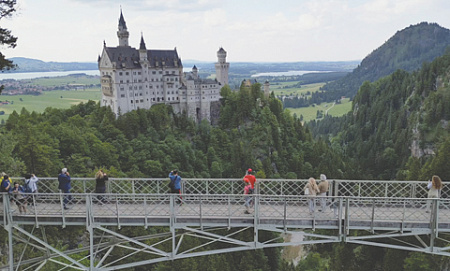
Germany’s iconic Neuschwanstein Castle, a 19th-century Romanesque Revival palace perched on a rugged hill in Bavaria, has officially been inscribed on the UNESCO World Heritage list. The decision, announced at the 47th session of the World Heritage Committee in Paris, also includes other royal residences built by King Ludwig II—Linderhof, Herrenchiemsee, and the King’s House on Schachen—recognizing their outstanding architectural and cultural value and solidifying their status as global treasures.
Drawing nearly 1.5 million visitors annually, these castles are the product of the singular vision of King Ludwig II. Ascending to the Bavarian throne as a young and idealistic 18-year-old, Ludwig largely eschewed state affairs, preferring to immerse himself in a romanticized world of myths and legends. He channeled vast resources into constructing a series of elaborate palaces that would serve as personal retreats and magnificent stages for his fantasies, creating what Bavarian Prime Minister Markus Söder called a “fairy tale come true” upon hearing of the UNESCO honor.
Construction on Neuschwanstein, whose name translates to “New Swan Stone,” began in 1869. Inspired by the heroic German sagas that captivated him since childhood and the dramatic operas of his favorite composer, Richard Wagner, the castle was designed to look like an idealized medieval knight’s fortress. Its soaring towers, ornate turrets, and walled courtyard were not built for defense but as a monument to romanticism, a tangible blend of reality and imagination set against the stunning backdrop of the Bavarian Alps.
Despite its medieval appearance, Neuschwanstein was a marvel of 19th-century engineering. Ludwig II was a patron of new inventions, and his fantastical retreat featured modern conveniences unheard of in a typical royal residence of the era. The castle was equipped with central heating, running water on every floor, a flush toilet system, and an electric bell system for summoning servants. An elevator was even installed to transport meals from the kitchen to the royal dining quarters three floors above.
The lavish interior is a breathtaking testament to Ludwig’s obsessions. The two-story Throne Hall, designed in a Byzantine style with a star-spangled ceiling, was built to symbolize his divine right to rule, though the throne itself was never installed. Throughout the castle, magnificent wall paintings depict scenes from Wagner’s operas: the legend of Lohengrin unfolds in the grand salon, while the king’s own bedroom is a tribute to the tragic love story of Tristan and Isolde.
Tragically, Ludwig II would spend only a few months living in his unfinished masterpiece. In 1886, after being declared mentally unfit to rule by his government, he was deposed. Days later, the 40-year-old king was found dead under mysterious circumstances in the shallow waters of Lake Starnberg, a death that remains one of the most debated unsolved mysteries of the 19th century. Construction on the castle halted abruptly, leaving many of its more than 200 planned rooms incomplete.
What was once derided as a monarch’s extravagant folly has become one of Germany’s most profitable tourism assets, a remarkable and unintended investment in Bavaria’s future. In the summer, the castle that was built for one man now welcomes up to 6,000 visitors per day. The nearby Marienbrücke, a bridge suspended high above a gorge, offers the most famous postcard view and throngs with international tourists, particularly from Asia, all seeking the perfect photograph.
Neuschwanstein’s influence extends far beyond Bavaria. Its dramatic silhouette is believed to have inspired Pyotr Ilyich Tchaikovsky during the creation of his ballet “Swan Lake.” More famously, it served as the direct inspiration for the Sleeping Beauty Castle that has become the iconic logo of The Walt Disney Company. With its new UNESCO designation, the dream world of a tragic king has been cemented not only as a symbol of fantasy but as a protected piece of humanity’s shared heritage.
